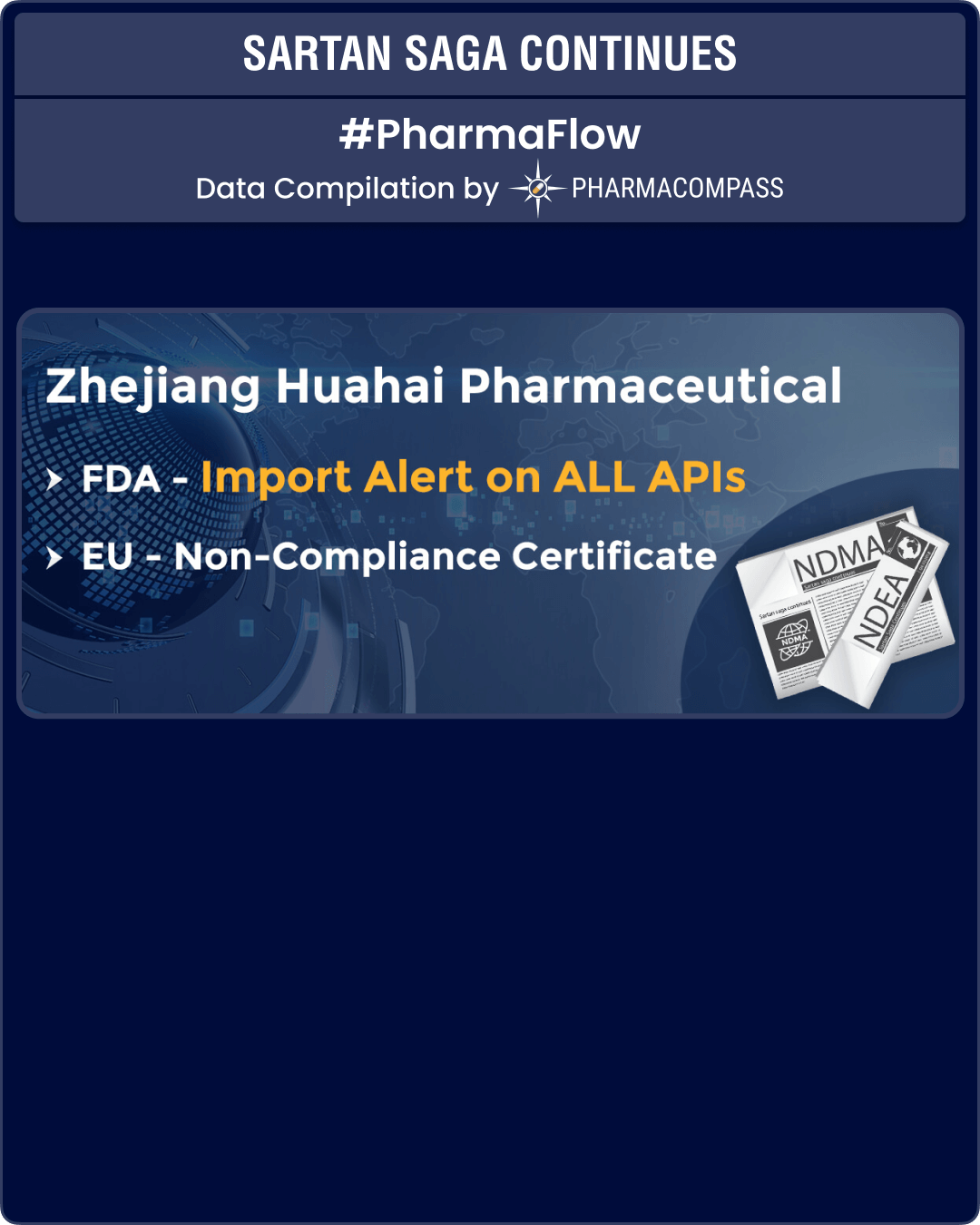
By PharmaCompass
2018-10-04
Impressions: 4950
In case you thought the US Food and Drug Administration (FDA) and EU’s actions against China’s Zhejiang Huahai Pharmaceutical (ZHP) for supplying commonly used blood pressure medicine valsartan with cancer-causing impurities, were over, you may want to think again.
Regulators in both US and Europe have stepped up action against ZHP. Last week, Phispers had reported how the US Food and Drug Administration (FDA) had posted an 11-observation, highly redacted Form 483 issued to ZHP (post an inspection of its active pharmaceutical ingredient facility) on its website on September 21, 2018.
Post that, on September 28, 2018, the agency placed the firm on import alert to “protect US patients while the active pharmaceutical ingredient (API) manufacturer fully determines how impurities were introduced into its API and remediates its quality systems.”
Similarly, European regulatory authorities issued Zhejiang Huahai a non-compliance certificate that prohibits the supply of valsartan and its intermediates to the EU market.
Import alert at Huahai to impact global API landscape
In 2007, Huahai became the first Chinese pharmaceutical manufacturer to receive FDA approval for a finished drug product (nevirapine). It continues to rank amongst the top Chinese drug master file (DMF) filers with the FDA.
As you are aware, in July this year, valsartan produced by ZHP was found to contain traces of N-nitrosodimethylamine (NDMA), a probable human carcinogen, due to a production change in 2012. The findings have prompted recalls in more than 50 countries.
Last month, FDA’s testing of products showed an additional unexpected impurity in three lots of Torrent Pharmaceuticals’ recalled valsartan drug products. This second impurity — N-Nitrosodiethylamine (NDEA) — is a known animal and suspected human carcinogen. These Torrent products were included in the company’s recall. NDEA too was detected in valsartan made by ZHP using its previous manufacturing process, before changes were introduced in 2012.
The FDA announcement issued last week said: “The import alert stops all API made by ZHP and finished drug products made using ZHP’s API from legally entering the United States.”
An import alert at ZHP’s facility is likely to have a significant impact on the global API supply landscape.
The FDA site shows 60 API DMFs of Huahai are Available for Reference for Generic Drug Applications in the United States. With each DMF assessment now requiring the applicant to submit a fee of US$ 55,013, the level of activity ZHP’s APIs generate in the US market and around the globe is significant.
EU issues non-compliance report
The FDA’s actions against ZHP weren’t isolated as an inspection by EU authorities in collaboration with European Directorate for the Quality of Medicines (EDQM) found that ZHP did not comply with Good Manufacturing Practice (GMP) in the manufacturing of valsartan at the site in Linhai, China.
The European inspection came after the suspension of the company’s CEP (a certificate of compliance with European standards for quality testing) for valsartan in July 2018. The inspection continued to focus on the manufacturing of valsartan.
The September 2018 inspection by investigators from the Italian Ministry of Health found nine “major” and eight “other” deviations at ZHP.
The European authorities found that the investigation conducted in the context of the NDMA/NDEA contamination of valsartan showed significant flaws. Moreover, the risk assessment performed in the context of the development/implementation of the optimized valsartan process, conducted in July/August 2018 (post the announcement of the recall) was also not satisfactory.
The regulator also raised data-integrity concerns in relation to GC-FID (gas chromatograph-flame ionization detector) analysis and found that the company conducted inadequate investigation of unknown peaks detected in GC-MS (gas chromatography–mass spectrometry) analysis of batches of valsartan manufactured with the new process.
While the company has already been prohibited to supply valsartan API to the EU market, the non-compliance report mentions that the EDQM should consider actions related to other valsartan CEPs in which Huahai is mentioned as an intermediate manufacturer.
The non-compliance certificate also prohibits the supply of valsartan intermediates to the EU market.
‘The responsibility is on the manufacturer’
In addition to the FDA’s change control guidance document, which was published last month, the FDA highlighted that manufacturers must recognize “that it is their responsibility to develop and use suitable methods to detect impurities, including when they make changes to their manufacturing processes. If a manufacturer detects new or higher levels of impurities, they should fully evaluate the impurities and take action to ensure the product is safe.”
While the FDA has not announced additional product recalls other than those already in place for valsartan medicines (and same is the case in the EU), it remains to be seen if the problems at Huahai create significant disruptions to the global API supply chain.
The PharmaCompass Newsletter – Sign Up, Stay Ahead
Feedback, help us to improve. Click here
Image Credit : SARTAN SAGA CONTINUES by PharmaCompass is licensed under CC BY 2.0
“ The article is based on the information available in public and which the author believes to be true. The author is not disseminating any information, which the author believes or knows, is confidential or in conflict with the privacy of any person. The views expressed or information supplied through this article is mere opinion and observation of the author. The author does not intend to defame, insult or, cause loss or damage to anyone, in any manner, through this article.”








